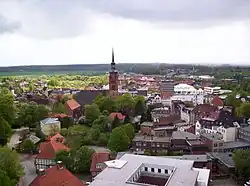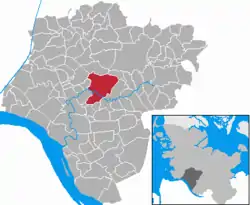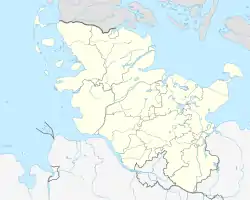Itzehoe
Itzehoe (German: [ɪtsəˈhoː] ⓘ; Low German: Itzhoe) is a town in the German state of Schleswig-Holstein.
Itzehoe | |
|---|---|
 Center of the town | |
 Coat of arms | |
Location of Itzehoe within Steinburg district  | |
 Itzehoe  Itzehoe | |
| Coordinates: 53°55′30″N 9°30′59″E | |
| Country | Germany |
| State | Schleswig-Holstein |
| District | Steinburg |
| Government | |
| • Mayor | Ralf Hoppe (Ind.) |
| Area | |
| • Total | 28.03 km2 (10.82 sq mi) |
| Elevation | 22 m (72 ft) |
| Population (2021-12-31)[1] | |
| • Total | 31,855 |
| • Density | 1,100/km2 (2,900/sq mi) |
| Time zone | UTC+01:00 (CET) |
| • Summer (DST) | UTC+02:00 (CEST) |
| Postal codes | 25501−25524 |
| Dialling codes | 04821 |
| Vehicle registration | IZ |
| Website | www.itzehoe.de |
As the capital of the district Steinburg, Itzehoe is located on the Stör, a navigable tributary of the Elbe, 51 km (31.7 mi) northwest of Hamburg and 24 km (14.9 mi) north of Glückstadt. The population is about 32,530.
History
Itzehoe is the oldest town in Holstein. Its nucleus was a castle, built in 809 by Egbert, one of Charlemagne's counts, against the Danes. The community that sprang up around it was variously called Esseveldoburg, Eselsfleth and Ezeho. In 1201 the town was destroyed but it was restored in 1224. The new town was granted the Lübeck rights by Adolphus IV in 1238 and the old town in 1303. During the Thirty Years' War Itzehoe was twice destroyed by the Swedes, in 1644 and 1657, but was rebuilt on each occasion. It passed to Prussia in 1867, with the duchy of Schleswig-Holstein.[2]
Itzehoe was listed as a garrison depot (Wehrkreis X (Hamburg)) of the former 225th Infantry Division, which was implicated in the 1940 Vinkt Massacre in Belgium.
During World War II, Itzehoe was not initially a primary target for the Allied strategic bombing campaign, but was hit by an Allied bombing raid very late in the war, when Allied carpet bombing on 2 May 1945 (just two days before the German surrender at Lüneburg Heath) caused 22 fatalities in the city.[3]: 436
Climate
| Climate data for Itzehoe (1991–2020 normals) | |||||||||||||
|---|---|---|---|---|---|---|---|---|---|---|---|---|---|
| Month | Jan | Feb | Mar | Apr | May | Jun | Jul | Aug | Sep | Oct | Nov | Dec | Year |
| Average high °C (°F) | 4.1 (39.4) |
4.9 (40.8) |
8.3 (46.9) |
14.1 (57.4) |
17.7 (63.9) |
20.8 (69.4) |
23.0 (73.4) |
22.6 (72.7) |
19.1 (66.4) |
13.8 (56.8) |
8.6 (47.5) |
5.6 (42.1) |
13.5 (56.3) |
| Daily mean °C (°F) | 2.0 (35.6) |
2.3 (36.1) |
4.3 (39.7) |
8.7 (47.7) |
12.5 (54.5) |
15.5 (59.9) |
17.7 (63.9) |
17.5 (63.5) |
14.2 (57.6) |
10.3 (50.5) |
6.1 (43.0) |
3.4 (38.1) |
9.5 (49.1) |
| Average low °C (°F) | −0.7 (30.7) |
−0.8 (30.6) |
0.2 (32.4) |
3.2 (37.8) |
6.6 (43.9) |
10.0 (50.0) |
12.2 (54.0) |
12.1 (53.8) |
9.4 (48.9) |
6.2 (43.2) |
3.1 (37.6) |
0.9 (33.6) |
5.2 (41.4) |
| Average precipitation mm (inches) | 85.9 (3.38) |
63.3 (2.49) |
53.7 (2.11) |
33.4 (1.31) |
61.3 (2.41) |
76.5 (3.01) |
99.9 (3.93) |
94.0 (3.70) |
70.3 (2.77) |
74.8 (2.94) |
75.4 (2.97) |
87.5 (3.44) |
883.9 (34.80) |
| Average precipitation days (≥ 1.0 mm) | 19.5 | 16.4 | 15.3 | 13.1 | 14.2 | 15.3 | 16.5 | 17.8 | 15.3 | 17.1 | 18.8 | 20.7 | 201.0 |
| Average relative humidity (%) | 89.2 | 86.2 | 81.3 | 74.7 | 73.6 | 75.3 | 76.2 | 78.6 | 82.7 | 86.3 | 90.0 | 91.0 | 82.1 |
| Mean monthly sunshine hours | 40.3 | 66.6 | 123.1 | 193.9 | 227.1 | 218.4 | 225.1 | 191.4 | 154.8 | 110.7 | 52.3 | 33.3 | 1,630.7 |
| Source: World Meteorological Organization[4] | |||||||||||||
Sights
The Church of St. Laurentii and the building in which the Holstein estates formerly met are noteworthy. The town has a convent founded in 1256, many schools, a hospital and other benevolent institutions.[2]
Itzehoe is also the location of the Wenzel Hablik Museum.
Transport
Itzehoe is situated at the Marsh Railway and offers connections to Hamburg and the island of Sylt.
During the period up to and including the Wacken Open Air festival many festival goers depart for the festival from Itzehoe using the 'Metal Shuttle Bus’, which leaves from near Itzehoe station. During this time the town can become very overcrowded and inundated with traffic.
Twin towns – sister cities
 Cirencester, England, United Kingdom
Cirencester, England, United Kingdom La Couronne, France
La Couronne, France Pasłęk, Poland
Pasłęk, Poland
Notable people
- Joachim Irgens von Westervick (1611-1675), Dano-Norwegian official and estate owner, one of the most important financial magnates and entrepreneurs
- Carl Julian (von) Graba (1799–1874), German lawyer and ornithologist who visited and studied the Faroe Islands
- Carl Johann Heinrich Leschen[6] (1808 – 1900), Music composer and organist
- Bruno Adler (1896–1954), Bishop of the German Christians
- Hans-Joachim Newiger (1925–2011), philologist
- H. G. Francis (1936–2011), writer
- Sabine Sinjen (1942–1995), actress
- Jerzy Janeczek (1944–2021), Polish actor
- Antje Blumenthal (born 1947), politician
- Sylvia Convey (born 1948), Latvian-Australian artist
- Olaf Berner (born 1949), teacher and handball player
- Heiger Ostertag (born 1953), historian
- Thomas Gerull (born 1962), fencer, Olympic medalist
- Sven Butenschön (born 1976), ice hockey player
- Lisa Tomaschewsky (born 1988), actress
References
- "Bevölkerung der Gemeinden in Schleswig-Holstein 4. Quartal 2021" (XLS) (in German). Statistisches Amt für Hamburg und Schleswig-Holstein.
- One or more of the preceding sentences incorporates text from a publication now in the public domain: Chisholm, Hugh, ed. (1911). "Itzehoe". Encyclopædia Britannica. Vol. 15 (11th ed.). Cambridge University Press. p. 87.
- Irmisch, Rudolf (1960). "Die Zeit des Nationalsozialismus (1933–1945)". Geschichte der Stadt Itzehoe. Itzehoe: Gruner & Sohn. pp. 424–439.
- "World Meteorological Organization Climate Normals for 1991–2020". World Meteorological Organization Climatological Standard Normals (1991–2020). National Oceanic and Atmospheric Administration. Archived from the original on 12 October 2023. Retrieved 12 October 2023.
- "Städtepartnerschaften". itzehoe.de (in German). Itzehoe. Retrieved 2021-02-15.
- https://www.kirche-itzehoe.de/isg/musik/orgeln/organisten-an-st-laurentii/
External links
- Itzehoe Notgeld (emergency banknotes) depicting the inflation of staple prices in Germany between 1913 and 1921